超早产儿
- 格式:ppt
- 大小:1.05 MB
- 文档页数:20
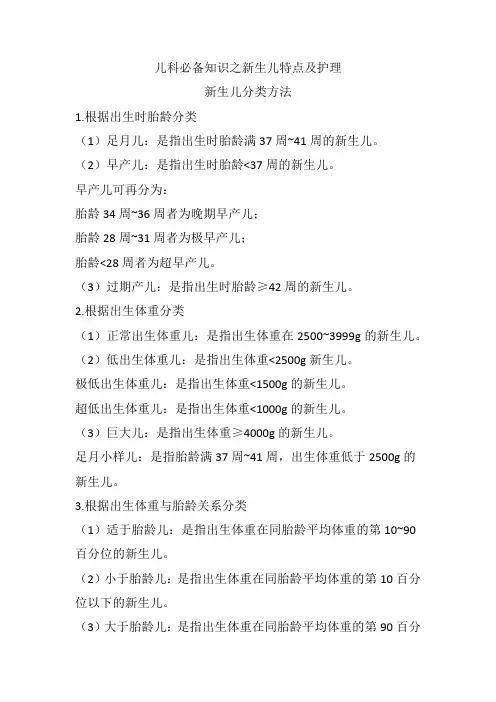
儿科必备知识之新生儿特点及护理新生儿分类方法1.根据出生时胎龄分类(1)足月儿:是指出生时胎龄满37周~41周的新生儿。
(2)早产儿:是指出生时胎龄<37周的新生儿。
早产儿可再分为:胎龄34周~36周者为晚期早产儿;胎龄28周~31周者为极早产儿;胎龄<28周者为超早产儿。
(3)过期产儿:是指出生时胎龄≥42周的新生儿。
2.根据出生体重分类(1)正常出生体重儿:是指出生体重在2500~3999g的新生儿。
(2)低出生体重儿:是指出生体重<2500g新生儿。
极低出生体重儿:是指出生体重<1500g的新生儿。
超低出生体重儿:是指出生体重<1000g的新生儿。
(3)巨大儿:是指出生体重≥4000g的新生儿。
足月小样儿:是指胎龄满37周~41周,出生体重低于2500g的新生儿。
3.根据出生体重与胎龄关系分类(1)适于胎龄儿:是指出生体重在同胎龄平均体重的第10~90百分位的新生儿。
(2)小于胎龄儿:是指出生体重在同胎龄平均体重的第10百分位以下的新生儿。
(3)大于胎龄儿:是指出生体重在同胎龄平均体重的第90百分位以上的新生儿。
4.根据出生后周龄分类早期新生儿是指出生后1周以内的新生儿。
晚期新生儿是指出生后第2~4周末的新生儿。
5.高危新生儿:是指已发生或可能发生危重疾病而需要监护的新生儿正常足月儿特点1.外观特点:正常足月儿外貌成熟,神态自若。
2.呼吸系统:胎儿肺内充满肺液。
足月儿肺液约30~35ml/kg,出生时经产道挤压排出和由肺血管及淋巴系统吸收和转运。
正常新生儿呼吸频率较快,约为40~50次/min,主要靠膈肌运动,呈腹式呼吸。
3.循环系统:正常新生儿出生后血液循环发生显著变化:①脐带结扎,胎盘-脐血液循环终止;②随着呼吸建立、肺膨胀,肺循环阻力下降,肺血流增加;③从肺静脉回流到左心房的血量显著增加,压力增高,使卵圆孔关闭;④由于PaO2增高,动脉导管收缩,继而关闭,完成胎儿循环向成人循环的转变,现称新生儿持续肺动脉高压。
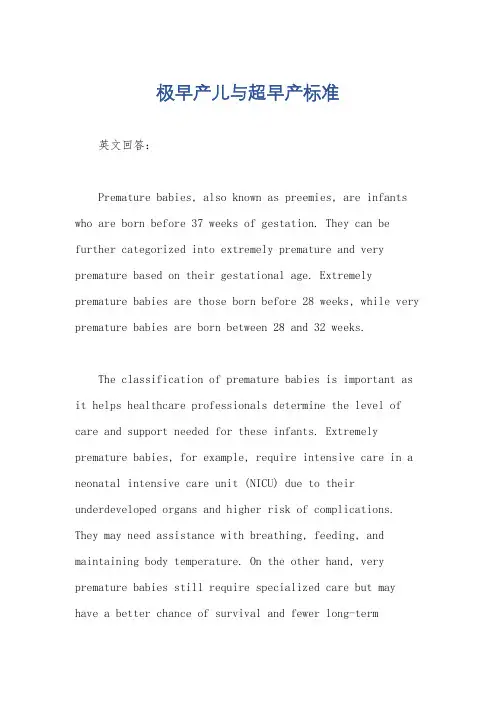
极早产儿与超早产标准英文回答:Premature babies, also known as preemies, are infants who are born before 37 weeks of gestation. They can be further categorized into extremely premature and very premature based on their gestational age. Extremely premature babies are those born before 28 weeks, while very premature babies are born between 28 and 32 weeks.The classification of premature babies is important as it helps healthcare professionals determine the level of care and support needed for these infants. Extremely premature babies, for example, require intensive care in a neonatal intensive care unit (NICU) due to their underdeveloped organs and higher risk of complications. They may need assistance with breathing, feeding, and maintaining body temperature. On the other hand, very premature babies still require specialized care but may have a better chance of survival and fewer long-termcomplications compared to extremely premature babies.To determine the gestational age of a premature baby, healthcare providers use different methods such as ultrasound, physical examination, and maternal history. These methods help estimate the baby's development and guide the appropriate management and interventions.It is important to note that the classification of premature babies is not a rigid definition, and there can be variations in different healthcare settings and countries. For example, some countries may consider babies born at 36 weeks as premature, while others may consider them full-term. The classification also depends on factors such as the baby's weight, overall health, and medical conditions.In my personal experience, my niece was born at 30 weeks gestation, making her a very premature baby. She spent several weeks in the NICU, where she received specialized care and support. She required assistance with breathing and feeding initially but gradually improved overtime. Today, she is a healthy and active toddler, showingno significant long-term complications from her premature birth.中文回答:极早产儿,也被称为早产儿,是指在孕期不满37周时出生的婴儿。
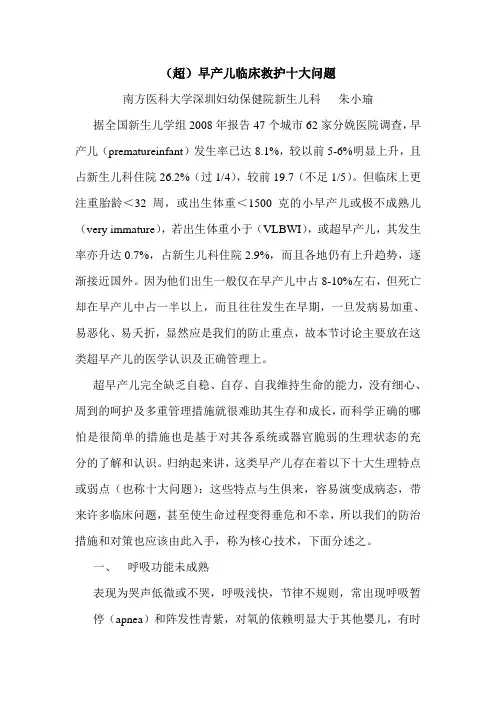
(超)早产儿临床救护十大问题南方医科大学深圳妇幼保健院新生儿科朱小瑜据全国新生儿学组2008年报告47个城市62家分娩医院调查,早产儿(prematureinfant)发生率已达8.1%,较以前5-6%明显上升,且占新生儿科住院26.2%(过1/4),较前19.7(不足1/5)。
但临床上更注重胎龄<32周,或出生体重<1500克的小早产儿或极不成熟儿(very immature),若出生体重小于(VLBWI),或超早产儿,其发生率亦升达0.7%,占新生儿科住院2.9%,而且各地仍有上升趋势,逐渐接近国外。
因为他们出生一般仅在早产儿中占8-10%左右,但死亡却在早产儿中占一半以上,而且往往发生在早期,一旦发病易加重、易恶化、易夭折,显然应是我们的防止重点,故本节讨论主要放在这类超早产儿的医学认识及正确管理上。
超早产儿完全缺乏自稳、自存、自我维持生命的能力,没有细心、周到的呵护及多重管理措施就很难助其生存和成长,而科学正确的哪怕是很简单的措施也是基于对其各系统或器官脆弱的生理状态的充分的了解和认识。
归纳起来讲,这类早产儿存在着以下十大生理特点或弱点(也称十大问题):这些特点与生俱来,容易演变成病态,带来许多临床问题,甚至使生命过程变得垂危和不幸,所以我们的防治措施和对策也应该由此入手,称为核心技术,下面分述之。
一、呼吸功能未成熟表现为哭声低微或不哭,呼吸浅快,节律不规则,常出现呼吸暂停(apnea)和阵发性青紫,对氧的依赖明显大于其他婴儿,有时停氧过早过急会诱发apnea(但无指征给氧和血氧分压高又会引起早产儿视网膜病,均需仔细观察择吉实施),奶后(特别是喂得过多过快)也容易发生青紫,因为:1.呼吸中枢未臻成熟:发放冲动不强,呼吸运动弱,节律会时快时慢(快时居多),甚至一过性呼吸停止,十多秒内又自行恢复或刺激后恢复,这种现象甚至可持续到生后一二十天,曾遇一例小早产儿控制了早期HMD和感染后,已停氧输液仅单纯喂养,精神好,体重每日增长,但却不定时一日数次突发apnea,全身青紫,心率减慢(或至停),立即予以拍打刺激和/或正压通气救护后每每缓解,一切恢复正常,以后随着其成熟不治而愈。

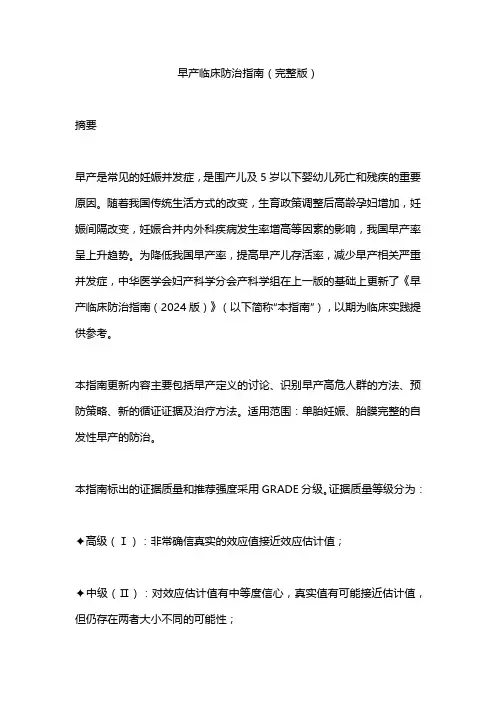
早产临床防治指南(完整版)摘要早产是常见的妊娠并发症,是围产儿及5岁以下婴幼儿死亡和残疾的重要原因。
随着我国传统生活方式的改变,生育政策调整后高龄孕妇增加,妊娠间隔改变,妊娠合并内外科疾病发生率增高等因素的影响,我国早产率呈上升趋势。
为降低我国早产率,提高早产儿存活率,减少早产相关严重并发症,中华医学会妇产科学分会产科学组在上一版的基础上更新了《早产临床防治指南(2024版)》(以下简称“本指南”),以期为临床实践提供参考。
本指南更新内容主要包括早产定义的讨论、识别早产高危人群的方法、预防策略、新的循证证据及治疗方法。
适用范围:单胎妊娠、胎膜完整的自发性早产的防治。
本指南标出的证据质量和推荐强度采用GRADE分级。
证据质量等级分为:✦高级(Ⅰ):非常确信真实的效应值接近效应估计值;✦中级(Ⅱ):对效应估计值有中等度信心,真实值有可能接近估计值,但仍存在两者大小不同的可能性;✦低级(Ⅲ):对效应估计值的确信程度有限,真实值可能与估计值大小不同;✦极低级(Ⅳ):对效应估计值几乎没有信心,真实值很可能与估计值大不相同。
推荐强度等级分为3级,强烈推荐(A):明确显示干预措施利大于弊或弊大于利;弱推荐(B):利弊不确定或无论质量高低的证据均显示利弊相当;良好实践声明(C):基于非直接证据或专家意见、经验形成的推荐。
01早产的定义及分类早产定义的上限全球统一,即妊娠不满37周分娩;而下限设置各国不同,受社会经济状况、文化、教育、遗传、医疗保健水平及早产儿救治能力等多种因素影响。
根据中华医学会妇产科学分会产科学组的两次Delphi调查结果,本指南早产下限采用妊娠满28周或新生儿出生体重≥1000g的标准;但是,提倡积极救治≥26周胎龄的超早产儿,有条件的地区在产妇及家属充分知情同意的前提下,不放弃对24~<26周有生机儿的救治。
根据发生的原因不同,早产可分为自发性早产和治疗性早产。
前者包括早产和胎膜早破后早产;后者是因妊娠合并症或并发症,为母儿安全需要提前终止妊娠。

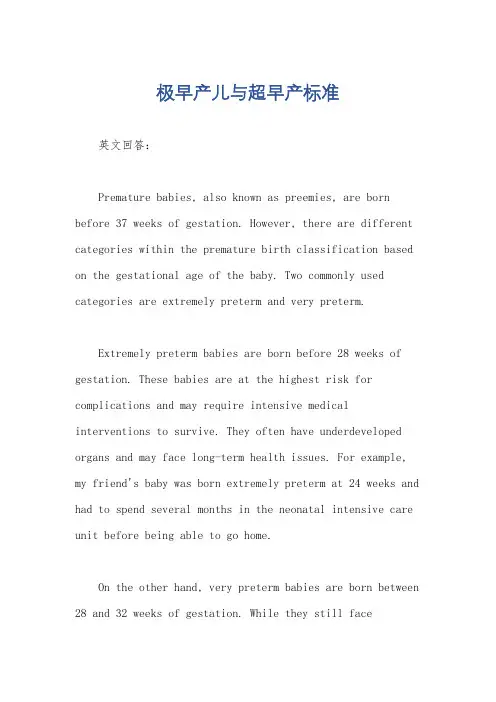
极早产儿与超早产标准英文回答:Premature babies, also known as preemies, are born before 37 weeks of gestation. However, there are different categories within the premature birth classification based on the gestational age of the baby. Two commonly used categories are extremely preterm and very preterm.Extremely preterm babies are born before 28 weeks of gestation. These babies are at the highest risk for complications and may require intensive medical interventions to survive. They often have underdeveloped organs and may face long-term health issues. For example, my friend's baby was born extremely preterm at 24 weeks and had to spend several months in the neonatal intensive care unit before being able to go home.On the other hand, very preterm babies are born between 28 and 32 weeks of gestation. While they still facesignificant challenges, their prognosis is generally better compared to extremely preterm babies. They may stillrequire specialized care and support, but their chances of survival and long-term health outcomes are improved. For instance, my cousin's baby was born very preterm at 30 weeks and had to stay in the hospital for a few weeks to gain weight and develop before being discharged.It is important to note that these categorizations are not fixed and may vary depending on the healthcare provider or country. Some healthcare providers may use different gestational age cut-offs to define extremely preterm and very preterm babies. Additionally, other factors such as birth weight and overall health condition also play a rolein determining the level of prematurity and the required medical interventions.中文回答:极早产儿,也被称为早产儿,是指在孕期不到37周出生的婴儿。
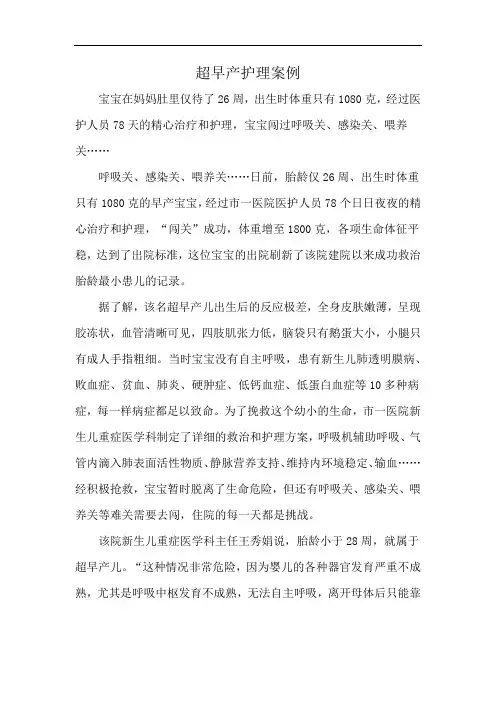
超早产护理案例宝宝在妈妈肚里仅待了26周,出生时体重只有1080克,经过医护人员78天的精心治疗和护理,宝宝闯过呼吸关、感染关、喂养关……呼吸关、感染关、喂养关……日前,胎龄仅26周、出生时体重只有1080克的早产宝宝,经过市一医院医护人员78个日日夜夜的精心治疗和护理,“闯关”成功,体重增至1800克,各项生命体征平稳,达到了出院标准,这位宝宝的出院刷新了该院建院以来成功救治胎龄最小患儿的记录。
据了解,该名超早产儿出生后的反应极差,全身皮肤嫩薄,呈现胶冻状,血管清晰可见,四肢肌张力低,脑袋只有鹅蛋大小,小腿只有成人手指粗细。
当时宝宝没有自主呼吸,患有新生儿肺透明膜病、败血症、贫血、肺炎、硬肿症、低钙血症、低蛋白血症等10多种病症,每一样病症都足以致命。
为了挽救这个幼小的生命,市一医院新生儿重症医学科制定了详细的救治和护理方案,呼吸机辅助呼吸、气管内滴入肺表面活性物质、静脉营养支持、维持内环境稳定、输血……经积极抢救,宝宝暂时脱离了生命危险,但还有呼吸关、感染关、喂养关等难关需要去闯,住院的每一天都是挑战。
该院新生儿重症医学科主任王秀娟说,胎龄小于28周,就属于超早产儿。
“这种情况非常危险,因为婴儿的各种器官发育严重不成熟,尤其是呼吸中枢发育不成熟,无法自主呼吸,离开母体后只能靠呼吸机以及各种仪器维持生命,救治难度很大。
早产儿体重越轻存活率越低,除了先进的设备,还需要非常细致的护理。
”这名胎龄仅26周的小宝宝发育更不成熟,期间多次出现频繁的呼吸暂停,市一医院新生儿重症医学科医护人员经过多次调整呼吸支持方案,最终让宝宝脱离了呼吸机。
同时,宝宝胎龄小,吸吮吞咽功能、胃肠道发育也极不成熟,护士们从一滴一滴喂奶开始,逐步锻炼患儿的吸吮吞咽功能,出院时宝宝每次可以吃奶40毫升。


极早产儿与超早产标准英文回答:Premature babies, also known as preemies, are babies who are born before the 37th week of pregnancy. They are categorized into different levels depending on how early they are born. Extremely premature babies are those who are born before 28 weeks, while very premature babies are born between 28 and 32 weeks.The classification of premature babies is important because it helps healthcare professionals determine the level of care and support these babies need. It also helps in predicting the potential complications and long-term outcomes for these babies.For extremely premature babies, they are at a higher risk of developing various health issues due to their underdeveloped organs and systems. These babies often require intensive care in a neonatal intensive care unit(NICU) and may need assistance with breathing, feeding, and maintaining body temperature.On the other hand, very premature babies have aslightly higher chance of survival and fewer complications compared to extremely premature babies. They may still require some assistance with breathing and feeding, but their overall prognosis is generally better.To illustrate the difference between extremely premature and very premature babies, let's consider two hypothetical cases. Baby A is born at 25 weeks gestation, making him an extremely premature baby. He requires immediate intubation and placement on a ventilator to help him breathe. He also needs to be fed through a feeding tube as he is not yet able to coordinate sucking and swallowing.Baby B, on the other hand, is born at 30 weeks gestation, making him a very premature baby. While he still needs assistance with breathing, he is able to breathe on his own with the help of nasal continuous positive airway pressure (CPAP). He is also able to take some feeds bymouth, although he still requires some supplementalnutrition through a feeding tube.中文回答:极早产儿,也被称为早产儿,是指在孕期不满37周出生的婴儿。

超早产儿预防颅内出血的护理措施
超早产儿是指出生时孕周不足28周的婴儿。
由于其未完全发育的特点,超早产儿更容易出现各种并发症,其中颅内出血是一种常见且严重的并发症。
颅内出血可能会对婴儿的生命造成严重威胁,因此预防颅内出血成为超早产儿护理中的重要工作。
以下是一些预防颅内出血的护理措施:
1. 保持合适的体位,超早产儿在护理过程中需要保持合适的体位,避免头部受到过度挤压或者摔打,以减少颅内出血的风险。
2. 避免剧烈晃动,在护理过程中,要避免对超早产儿进行剧烈晃动,以免造成颅内出血。
3. 控制合适的体温,超早产儿对体温的适应能力较差,容易出现体温过高或过低的情况。
保持适宜的体温有助于减少颅内出血的发生。
4. 定期监测生命体征,定期监测超早产儿的生命体征,及时发现异常情况并进行处理,有助于预防颅内出血的发生。
5. 给予适当的营养支持,营养不良也是导致颅内出血的一个重
要因素,给予超早产儿适当的营养支持有助于降低颅内出血的风险。
6. 注意感染防控,感染是颅内出血的一个重要诱因,因此要注
意超早产儿的感染防控,及时发现并治疗感染症状。
在超早产儿的护理过程中,预防颅内出血是至关重要的一环。
医护人员应该密切关注超早产儿的各项生命体征和护理需求,采取
相应的护理措施,尽最大努力降低颅内出血的发生率,保障超早产
儿的健康和安全。
超早产儿救治历史
嘿,咱今儿来聊聊超早产儿救治历史这档子事儿啊!
你知道吗,这超早产儿啊,就像那刚刚破土而出的小嫩芽,无比脆弱又无比珍贵。
想想看,他们那么小就来到这个世界,得多不容易啊!
以前啊,面对这些小家伙,医生们就像是在黑暗中摸索的行者,每一步都走得小心翼翼,却又充满了未知和挑战。
那时候啊,技术可没现在这么发达,好多超早产儿都没能挺过来,真让人心疼啊!这就好比在风浪中前行的小船,随时都有被掀翻的危险。
但人类的智慧是无穷的呀!随着时间的推移,医生们不断钻研,各种新的技术和方法就像雨后春笋一样冒了出来。
保温箱就像是小宝贝们的温暖小窝,给他们提供了适宜的环境;那些先进的医疗设备,就像是小战士们的武器,帮助医生们和死神战斗。
现在啊,超早产儿的救治成功率可比以前高多啦!这可不是吹的哦!就好像爬山,以前只能艰难地爬几步,现在呢,能爬得更高更远啦!你说神奇不神奇?
咱再想想啊,要是没有这些努力和进步,那得有多少可爱的小生命被错过啊!那些原本可能消逝的笑容和希望,因为有了这些努力而被留住了。
这多让人感动啊!
救治超早产儿,不只是医生的事儿,也是全社会的事儿。
就好像盖房子,需要好多人一起努力才行。
家长们的爱和坚持,就像那坚实的基
石;医护人员的专业和付出,就像那稳固的梁柱;社会各界的支持和关注,就像那温暖的阳光。
大家齐心协力,才能让这些小生命茁壮成长。
咱可得好好珍惜现在的成果呀,这都是无数人努力奋斗得来的呢!以后啊,肯定还会有更多更好的方法和技术出现,那时候,超早产儿的救治肯定会更上一层楼!难道不是吗?让我们一起期待吧!。
http ://中西医结合护理Chinese Journal of Integrative Nursing2022年第8卷第1期Vol.8,No.1,2022OPEN ACCESS极早和超早产儿呼吸暂停临床干预方法进展陆丽君1,冯雪茉1,卢运红2(1.广西医科大学附属传染病医院感染科一病区,广西南宁,530021;2.广西医科大学护理学院护理学教研室,广西南宁,530021)摘要:新生儿呼吸暂停多见于极早产儿或超早产儿,受感受器发育不全、电解质紊乱、细菌病毒感染等多种综合因素的影响,容易导致新生儿出现大脑缺血缺氧等并发症,是造成新生儿死亡的主要原因。
本文通过分析、归纳、比较极早产儿及超早产儿呼吸暂停临床干预方法,以期为进一步开展有效干预提供依据。
关键词:呼吸暂停;极早产儿;超早产儿;体位;感染;哺乳中图分类号:R 473.72文献标志码:A文章编号:2709-1961(2022)01-0142-05Research progress of clinical intervention for apnea in extremely and very preterm infantsLU Lijun 1,FENG Xuemo 1,LU Yunhong 2(1.First Department of Infectious Diseases ,Infectious Diseases Hospital Affiliated toGuangxi Medical University ,Nanning ,Guangxi ,530021;2.Office of Nursing Teaching and Research ,School of Nursing Guangxi Medical University ,Nanning ,Guangxi ,530021)ABSTRACT :Neonatal apnea is more common in extremely or very preterm infants.Influencedby a variety of comprehensive factors such as hypoplasia of receptors ,electrolyte disorder ,bacte⁃rial and viral infection ,it is easy to lead to cerebral ischemia and hypoxia and other complications in neonates ,which is the main cause of neonatal death.By using the method of literature review ,induction and comparison ,this paper made an analysis of clinic interventions for apnea in extreme⁃ly and very preterm infants ,and provided a basis for further effective intervention.KEY WORDS :apnea ;extremely preterm infants ;very preterm infants ;position ;infection ;breastfeeding早产儿呼吸暂停是新生儿监护室中较为常见的病症,其主要是指早产儿呼吸道气流停止超过20s ,足月小儿呼吸暂停时间>15s ,同时伴随心率下降、皮肤发紫或全身苍白、四肢肌力减弱等临床指征[1]。